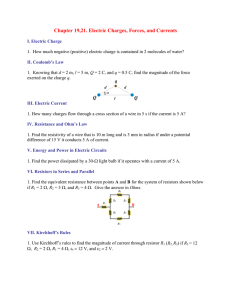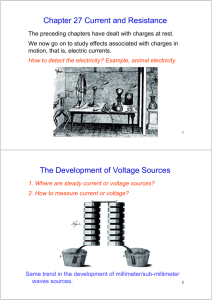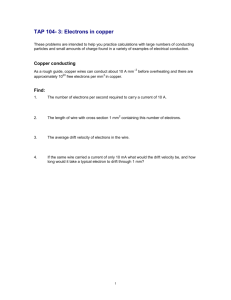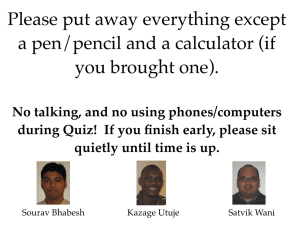Contents 1 Current and Resistance
advertisement
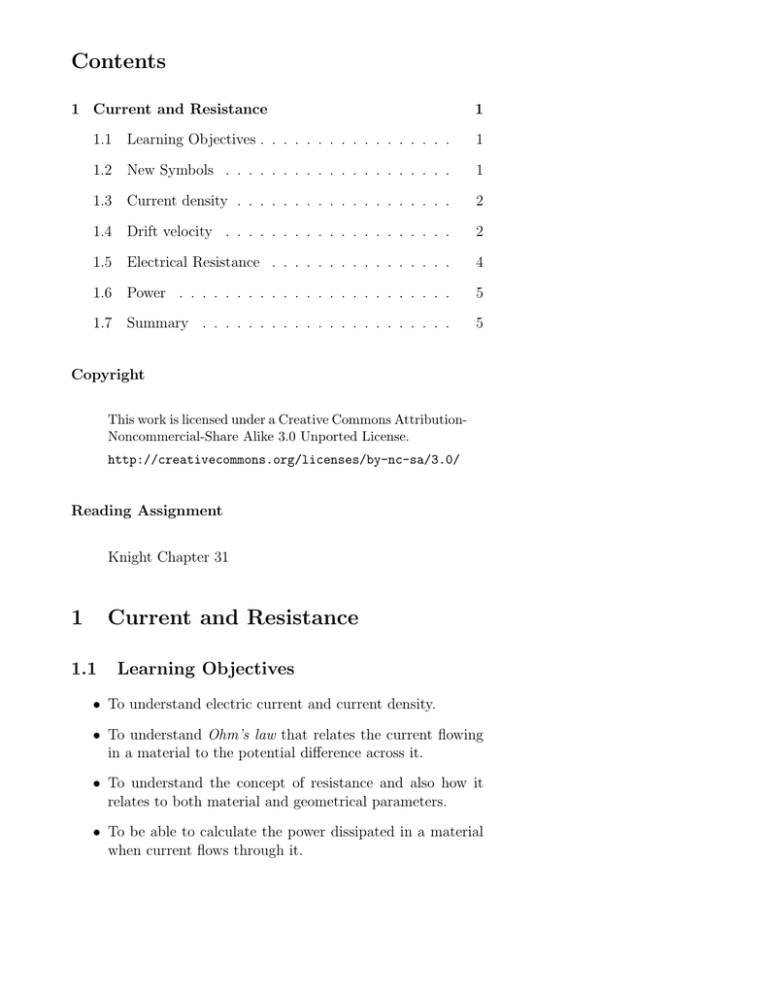
Contents 1 Current and Resistance 1 1.1 Learning Objectives . . . . . . . . . . . . . . . . . 1 1.2 New Symbols . . . . . . . . . . . . . . . . . . . . 1 1.3 Current density . . . . . . . . . . . . . . . . . . . 2 1.4 Drift velocity . . . . . . . . . . . . . . . . . . . . 2 1.5 Electrical Resistance . . . . . . . . . . . . . . . . 4 1.6 Power . . . . . . . . . . . . . . . . . . . . . . . . 5 1.7 Summary . . . . . . . . . . . . . . . . . . . . . . 5 Copyright This work is licensed under a Creative Commons AttributionNoncommercial-Share Alike 3.0 Unported License. http://creativecommons.org/licenses/by-nc-sa/3.0/ Reading Assignment Knight Chapter 31 1 Current and Resistance 1.1 Learning Objectives • To understand electric current and current density. • To understand Ohm’s law that relates the current flowing in a material to the potential difference across it. • To understand the concept of resistance and also how it relates to both material and geometrical parameters. • To be able to calculate the power dissipated in a material when current flows through it. 1.2 New Symbols Table 1: New Symbols I J σ ρ R current current density conductivity resistivity resistance A Am−2 1/Ωm Ωm Ω In a conducting wire, mobile charge carriers will move if there is difference in potential between the two ends of the wire Vab . The flow of charge is called a current. Va Vb E a b e- F A I conducting wire I= dQ dt Units : A (Ampères) The current is the amount of mobile charge that flows through a fixed surface (e.g. A on the Fig.) per unit time. • In a metal the mobile charge carriers are electrons and they will move to the left because Fx = −eEx . • An electron moving to the left with charge −e has the same effect as a positive charge +e moving to the right: (−e)(−vx ) = (+e)(+vx ) = evx and we defined current in terms of positive charge. • You can think in terms of positive charge; +e flowing to the right. This is called conventional current. • Discuss faucets and water with negative mass. 2 1.3 Current density If we normalize the current to the cross sectional area of the wire, we have the current density: J≡ 1.4 I A Units : Am−2 Drift velocity There are a lot of electrons in conductors and they do not all travel at the same speed. They have a range of speeds and they also don’t all move in the same direction. They move in both directions (left and right). The electrons that are moving most rapidly can be moving at ≈ c/100. The effect of the electric field is to change the average electron speed, or drift velocity 1 X vi , vd = N from zero to some finite value. Analogy: Traffic on the 401. Calculate the average speed by counting vehicles that pass a fixed point for an entire day. Then we will raise the 401 near Toronto by 5 km (e.g. add a gravitational potential) and calculate the average speed. t=0 I A Q t=t vdt E Q (Avd t)ne = = Anevd t t Where n is the electron concentration. Therefore, the current density is: I= J = nevd . 3 Example 1. Calculate the drift velocity for electrons in a copper wire with a diameter of 1.0 mm if it is carrying a current of I = 1A. The concentration of electrons on copper - basically one per atom - is n = 1.1 × 1029 m−3 . 1.5 Electrical Resistance The ratio of J to E is a constant for many materials and it is called the conductivity (σ). Materials with a high conductivity conduct well. The inverse of the conductivity is called the resistivity (ρ). 1 J =σ= . E ρ Ohm0 s Law Units: σ 1/Ωm; ρ Ωm. Question: What can we say about the ratio V /I ? Starting from Ohm’s law: J I L 1 = = E AV ρ we have V L = ρ ≡ R, I A Second form of Ohm0 s Law where R is the resistance of the material. Notice that the resistance contains both geometric (L and A) and materials (ρ) parameters: L R=ρ . A Units : Ω (Ohms) 4 Separating material parameters from geometrical parameters is a very smart thing to do. • If we double the length of the wire, the resistance doubles. • If we double the area of the wire, the resistance halves. This is how our resistor would be represented in a circuit diagram: V R I 1.6 A Power Considering the mobile charge carriers in the wire. P = U I U = I = I V. e e Using the second form of Ohm’s Law V = IR, we have two alternate forms V2 P =I R= . R 2 Units: W (Watts) = Js−1 . Example 2. A 12 V car starter motor draws I = 200 A. (a) Calculate the amount of power dissipated and (b) calculate the energy dissipated in a 5 s burst. 5 1.7 Summary • Current is the amount of mobile charge that flows through a fixed surface per unit time. (I = dQ/dt) • Current density J = I/A • Ohm’s Law: σ = J/E = 1/ρ where σ is the conductivity and ρ is the resistivity. • Resistance R = V /I = ρL//A • Power P = IV = I 2 R = V 2 /R 6



